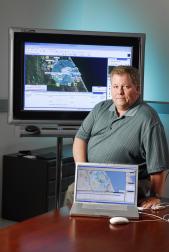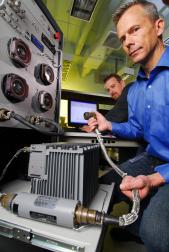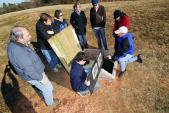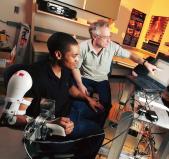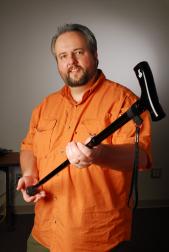"I believe new ideas occur at the boundaries of technical and scientific fields. That is one reason why the university's multidisciplinary focus is so right for our future," said Dr. Stephen Cross, appointed director of GTRI and vice president of Georgia Tech in 2003. Cross was also named a professor in the School of Industrial and Systems Engineering — a significant appointment in that it fosters a deeper understanding of both academic and industry-oriented research perspectives between Georgia Tech and the highest level at GTRI.
Cross brings a renewed emphasis on interdisciplinary research, along with a "commitment to technical excellence in core areas, while expanding our impact into new areas where our strong foundation of experience, expertise, and creativity can find useful applications."
In the 2000s, GTRI has applied its interdisciplinary approach to problem-solving while continuing to bolster its traditional strength in defense technology. In addition, student involvement in research has continued to grow under Cross' leadership. Projects of particular note follow.
AMBER Alert
GTRI facilitated the launch of a national AMBER Alert system in 2003. Today, more than 300 organizations participate in it. Upward of 100 abducted children have been found through the system, according to Cross, "and that's very gratifying."
Statewide Interoperable Communications System
The Georgia Office of Homeland Security and Georgia Emergency Management Agency also faced communications issues in 2004. GTRI's solution enables first responders and government officials anywhere in the state to communicate via radio with each other and with dispatchers in the event of an officially declared emergency.
Geographic Tool for Visualization and Collaboration
Originally developed by GTRI for the military, the Geographic Tool for Visualization and Collaboration is a collaborative mapping tool that helps law enforcement and emergency management officials better coordinate event and incident planning and real-time response.
Cargo Container Security
Preventing man-made disasters is another facet of GTRI research in the 2000s. One noteworthy project involves an interdisciplinary mix of packaging engineering, optics, and electronics to improve the security of cargo containers coming into United States’ ports. The result is a device that can be attached to containers and continuously monitors them for unauthorized attempts to open the container doors.
Using radio frequency (RFID) and novel sensor technology, the devices can communicate container information remotely to port authorities, providing a log detailing any time a door is opened, closed, or even removed. The sensor is designed to sound an alarm if an attempt is made to disable the system.
Defense Technology
In 2003, GTRI faced a critical project under a seemingly impossible deadline. The U.S. Air Force needed to improve the missile warning system used in military aircraft flown by the United States and its allies in Iraq and Afghanistan.
The Smart Cable is a system enhancement that simply plugs into the existing AAR-47 warning device used on several different airplane types, including the C-17, C-5, and C-130. While such an upgrade would normally require at least a year to complete, GTRI engineers designed and built a working prototype in only two months.
FalconView
One of GTRI's most successful U.S. Department of Defense products in the 1990s proved to be one of its most versatile in the 2000s. FalconViewTM is a software package that analyzes and displays geographical data crucial to mission planners. FalconView has been upgraded to allow programmers to extend its functionality for additional uses. Through the years, GTRI researchers have continued to expand its capabilities and make it more robust, particularly in the area of situational awareness.
Originally designed for the U.S. Air Force's F-16 Fighting Falcon, FalconView has since been adopted for use by a wide variety of aircraft and vehicles. Its use has also spread throughout other branches of the U.S. military and other federal agencies for air, ground, and sea operations.
FalconView currently has more than 45,000 users.
Hugo Folding Cane
As baby boomers make their way into retirement, GTRI sees tremendous potential in the marketplace for a range of medical and health-related technologies, including assistive technologies.
Researchers reviewed consumer concerns and needs before designing a slip-resistant device capable of withstanding 500 pounds of applied weight. Marketed by the project sponsor as the Hugo Folding Cane, it features an interchangeable handle so users can select the style and grip they like. The personalized handle attracted the attention of the producers of "House, M.D.," who arranged for the TV show's main character, Dr. Gregory House, to walk with a Hugo cane in several episodes.
Solar Latrine
In a 2005 project, a group of Georgia Tech undergraduates and graduate students, along with GTRI researchers, Georgia Tech and Emory University, designed and built a solution to a sanitation problem. The solar latrine has potential to dramatically improve the lives of millions of people in the poorest parts of the world. It was built with common parts that can be purchased at any hardware store. The latrine works by using the sun's heat to kill bacteria in collected waste.
A Focus on Education
Education has been a staple of GTRI's mission since its beginning and has grown exponentially in scope and reach.
In just 75 years of GTRI, around 41 GTRI research faculty were teaching in Georgia Tech's academic colleges. More than half of the courses offered through Georgia Tech Professional Education were taught by GTRI experts and engineers.
In addition, GTRI researchers make their expertise available to everyone through professional education offerings, which include:
- A professional master's degree in applied systems engineering,
- The Georgia Tech Defense Technology Professional Education Program, and
- Courses in occupational safety and health.

